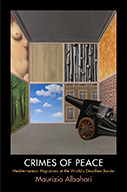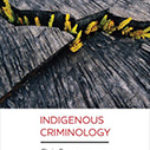Crimes Of Peace: Mediterranean Migration At The World’s Deadliest

Author: Maurizio Albahari
Publisher: Philadelphia: University of Pennsylvania Press, 2015. 288p.
Reviewer: Ines Hasselberg | March 2018
In Crimes of peace. Mediterranean migration at the world’s deadliest border Maurizio Albahari scrutinizes the policies, practices, discourses and politics addressing irregular cross-Mediterranean journeys. He does so through a comprehensive analysis of documentation (such as media, laws, human rights reports, and statements and declarations from a variety of civil and political actors at local, national and regional level), informed by over two decades of empirical research in the area. In Italy (but also in Albania, Tunisia, Libya and Egypt), Albahari has witnessed shipwrecks, visited detention centres, interviewed survivors, rescuers, coast guard officers, mayors, religious actors, politicians, civil society agents, and residents and mayors of coastal towns at the receiving end of the Mediterranean. Through a sound epistemological approach, Albahari was successful in producing an encompassing ethnography of the “seemingly nonlocatable mechanisms of power, and the genealogies and long-term implications of sovereignty” (25).
Over the past years the Mediterranean has come to be regarded as one of, if not the, deadliest borders in the world. ‘Crisis’ and ‘emergency’ are commonly used words in public discourse on it. At the start of the book, however, Albahari traces the genealogies of care and confinement (chapter 1) and rescue and pushbacks (chapter 2) in the region to reveal how the journeys, risks, responses and discourses of today are not recent but rather the development of much longer social and political processes and events. But how long can such events last? “Emergencies do not last two decades”, Albahari writes, “The political priorities, active policies, and structural negligence that perpetuate them as such do” (203).
In the subsequent chapters Albahari deconstructs the Mediterranean ‘emergency’. In doing so he complicates the military and humanitarian facets of rescue, showing how military surveillance and humanitarian concerns coexist in contradictory, yet incredibly efficient ways , as emergencies “methodically procrastinate to a never attainable future the analysis of the conditions that enable them” (13). And so, we read of rescue operations, followed by the detention of its survivors and their deportation to unsafe places. Shipwreck after shipwreck, death after death, pushback after pushback, the reader is confronted with not just disregard and negligence, but perhaps more disturbing, with indifference towards the lives and deaths of those crossing the sea. These are the crimes of peace – crimes that “ speak to the ambitious, laborious, and resilient administrative, political, and ideological work of maintaining a “system” that has proven crumbling and volatile and that keeps proving unjust, violent, and unequal” (21).
Crimes of Peace is written in a very accessible and engaging manner. It speaks both to academics and practitioners, and to the interested public. It is a book of interest to those concerned with migration, border control, processes of criminalisation, sovereignty, human rights and peace. Ultimately, however, this is a book about humanity.
Ines Hasselberg, Postdoctoral Research Fellow, Centre for Research in Anthropology, University of Minho


